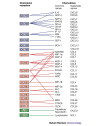Chemokine receptors: multifaceted therapeutic targets
- PMID: 11910892
- PMCID: PMC7097668
- DOI: 10.1038/nri722
Chemokine receptors: multifaceted therapeutic targets
Erratum in
- Nature Rev Immunol 2002 Mar;2(3):215
Abstract
Chemokines and their receptors are involved in the pathogenesis of diseases ranging from asthma to AIDS. Chemokine receptors are G-protein-coupled serpentine receptors that present attractive tractable targets for the pharmaceutical industry. It is only ten years since the first chemokine receptor was discovered, and the rapidly expanding number of antagonists holds promise for new medicines to combat diseases that are currently incurable. Here, I focus on the rationale for developing antagonists of chemokine receptors for inflammatory disorders and AIDS, and the accumulating evidence that favours this strategy despite the apparent redundancy in the chemokine system.
Figures




References
-
- Rollins BJ. Chemokines. Blood. 1997;90:909–928. - PubMed
-
- Luster AD. Chemokines — chemotactic cytokines that mediate inflammation. New Engl. J. Med. 1998;338:436–445. - PubMed
-
- Zlotnik A, Yoshie O. Chemokines: a new classification system and their role in immunity. Immunity. 2000;12:121–127. - PubMed
-
- Lin KC, Castro AC. Very late antigen 4 (VLA4) antagonists as anti-inflammatory agents. Curr. Opin. Chem. Biol. 1998;2:453–457. - PubMed
Publication types
MeSH terms
Substances
LinkOut - more resources
Full Text Sources
Other Literature Sources

